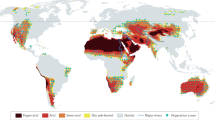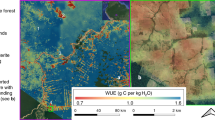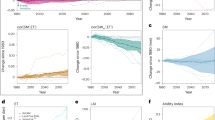Abstract
Biome function is largely governed by how efficiently available resources can be used and yet for water, the ratio of direct biological resource use (transpiration, E T) to total supply (annual precipitation, P) at ecosystem scales remains poorly characterized. Here, we synthesize field, remote sensing and ecohydrological modelling estimates to show that the biological water use fraction (E T/P) reaches a maximum under mesic conditions; that is, when evaporative demand (potential evapotranspiration, E P) slightly exceeds supplied precipitation. We estimate that this mesic maximum in E T/P occurs at an aridity index (defined as E P/P) between 1.3 and 1.9. The observed global average aridity of 1.8 falls within this range, suggesting that the biosphere is, on average, configured to transpire the largest possible fraction of global precipitation for the current climate. A unimodal E T/P distribution indicates that both dry regions subjected to increasing aridity and humid regions subjected to decreasing aridity will suffer declines in the fraction of precipitation that plants transpire for growth and metabolism. Given the uncertainties in the prediction of future biogeography, this framework provides a clear and concise determination of ecosystems' sensitivity to climatic shifts, as well as expected patterns in the amount of precipitation that ecosystems can effectively use.
This is a preview of subscription content, access via your institution
Access options
Access Nature and 54 other Nature Portfolio journals
Get Nature+, our best-value online-access subscription
$29.99 / 30 days
cancel any time
Subscribe to this journal
Receive 12 digital issues and online access to articles
$119.00 per year
only $9.92 per issue
Buy this article
- Purchase on SpringerLink
- Instant access to full article PDF
Prices may be subject to local taxes which are calculated during checkout



Similar content being viewed by others
References
Berg, A. et al. Land–atmosphere feedbacks amplify aridity increase over land under global warming. Nat. Clim. Change 6, 869–874 (2016).
Polson, D. & Hegerl, G. C. Strengthening contrast between precipitation in tropical wet and dry regions. Geophys. Res. Lett. 44, 365–373 (2017).
Caylor, K. K., Scanlon, T. M., Rodriguez-Iturbe, I. & Rodríguez-Iturbe, I. Ecohydrological optimization of pattern and processes in water-limited ecosystems: a trade-off-based hypothesis. Water Resour. Res. 45, W08407 (2009).
Haddeland, I. et al. Global water resources affected by human interventions and climate change. Proc. Natl Acad. Sci. USA 111, 3251–3256 (2014).
Cheng, L. et al. Recent increases in terrestrial carbon uptake at little cost to the water cycle. Nat. Commun. 8, 110 (2017).
Del Grosso, S. et al. Global potential net primary production predicted from vegetation class, precipitation, and temperature. Ecology 89, 2117–2126 (2008).
Huxman, T. E. et al. Convergence across biomes to a common rain-use efficiency. Nature 429, 651–654 (2004).
Bruijnzeel, L. A. & Veneklaas, E. J. Climatic conditions and tropical montane forest productivity: the fog has not lifted yet. Ecology 79, 3–9 (1998).
Schuur, E. A. G. Productivity and global climate revisited: the sensitivity of tropical forest growth to precipitation. Ecology 84, 1165–1170 (2003).
Smith, W. K. & McClean, T. M. Adaptive relationship between leaf water repellency, stomatal distribution, and gas exchange. J. Chem. Inf. Model. 96, 465–469 (1989).
Taylor, P. G. et al. Temperature and rainfall interact to control carbon cycling in tropical forests. Ecol. Lett. 20, 779–788 (2017).
Zhu, K., Chiariello, N. R., Tobeck, T., Fukami, T. & Field, C. B. Nonlinear, interacting responses to climate limit grassland production under global change. Proc. Natl Acad. Sci. USA 113, 10589–10594 (2016).
Sala, O. E., Parton, W. J., Joyce, L. A. & Lauenroth, W. K. Primary production of the central grassland region of the United States. Ecology 69, 40–45 (1988).
Mueller, K. E., Tilman, D., Fornara, D. A. & Hobbie, S. E. Root depth distribution and the diversity–productivity relationship in a long-term grassland experiment. Ecology 94, 787–793 (2013).
Good, S. P. & Caylor, K. K. Climatological determinants of woody cover in Africa. Proc. Natl Acad. Sci. USA 108, 4902–4907 (2011).
Vicente-Serrano, S. M. et al. Response of vegetation to drought time-scales across global land biomes. Proc. Natl Acad. Sci. USA 110, 52–57 (2013).
Yang, Y. et al. Contrasting responses of water use efficiency to drought across global terrestrial ecosystems. Sci. Rep. 6, 23284 (2016).
Bonell, M. Possible impacts of climate variability and change on tropical forest hydrology. Clim. Change 39, 215–272 (1998).
Foster, P. The potential negative impacts of global climate change on tropical montane cloud forests. Earth-Sci. Rev. 55, 73–106 (2001).
Schlesinger, W. H. & Jasechko, S. Transpiration in the global water cycle. Agric. For. Meteorol. 189–190, 115–117 (2014).
Wang, L., Good, S. P. & Caylor, K. K. Global synthesis of vegetation control on evapotranspiration partitioning. Geophys. Res. Lett. 41, 6753–6757 (2014).
Good, S. P., Noone, D. & Bowen, G. Hydrologic connectivity constrains partitioning of global terrestrial water fluxes. Science 349, 175–177 (2015).
Miralles, D. G. et al. The WACMOS-ET project—part 2: evaluation of global terrestrial evaporation data sets. Hydrol. Earth Syst. Sci. 20, 823–842 (2016).
Wang, L. et al. The effect of warming on grassland evapotranspiration partitioning using laser-based isotope monitoring techniques. Geochim. Cosmochim. Acta 111, 28–38 (2013).
Wei, Z. et al. Revisiting the contribution of transpiration to global terrestrial evapotranspiration. Geophys. Res. Lett. 44, 2792–2801 (2017).
Gibson, J. J. & Edwards, T. W. D. Regional water balance trends and evaporation—transpiration partitioning from a stable isotope survey of lakes in northern Canada. Glob. Biogeochem. Cycles 16, 10–11 (2002).
Maxwell, R. M. & Condon, L. E. Connections between groundwater flow and transpiration partitioning. Science 353, 377–380 (2016).
Moore, G. W. & Heilman, J. L. Proposed principles governing how vegetation changes affect transpiration. Ecohydrology 4, 351–358 (2011).
Budyko, M. I. Climate and Life (Academic Press, New York, NY, 1974).
Porporato, A., Daly, E. & Rodríguez-Iturbe, I. Soil water balance and ecosystem response to climate change. Am. Nat. 164, 625–632 (2004).
Laio, F., Porporato, A., Ridolfi, L., Rodríguez-Iturbe, I. & Ridol, L. Plants in water-controlled ecosystems: active role in hydrologic processes and response to water stress: II. Probabilistic soil moisture dynamics. Adv. Water Resour. 24, 707–723 (2001).
Wang, D., Wang, G. & Anagnostou, E. N. Evaluation of canopy interception schemes in land surface models. J. Hydrol. 347, 308–318 (2007).
Good, S. P., Guan, K. & Caylor, K. K. Global patterns of the contributions of storm frequency, intensity, and seasonality to interannual variability of precipitation. J. Clim. 29, 3–15 (2016).
Yang, Y., Donohue, R. J. & McVicar, T. R. Global estimation of effective plant rooting depth: implications for hydrological modeling. Water Resour. Res. 52, 8260–8276 (2016).
Zomer, R. J., Trabucco, A., Bossio, D. A. & Verchot, L. V. Climate change mitigation: a spatial analysis of global land suitability for clean development mechanism afforestation and reforestation. Agric. Ecosyst. Environ. 126, 67–80 (2008).
Roderick, M. L., Sun, F., Lim, W. H. & Farquhar, G. D. A general framework for understanding the response of the water cycle to global warming over land and ocean. Hydrol. Earth Syst. Sci. 18, 1575–1589 (2014).
Byrne, M. P., O’Gorman, P. A., Byrne, M. P. & O’Gorman, P. A. The response of precipitation minus evapotranspiration to climate warming: why the ‘wet-get-wetter, dry-get-drier’ scaling does not hold over land. J. Clim. 28, 8078–8092 (2015).
Wu, H.-T. J. & Lau, W. K.-M. Detecting climate signals in precipitation extremes from TRMM (1998–2013)—increasing contrast between wet and dry extremes during the ‘global warming hiatus’. Geophys. Res. Lett. 43, 1340–1348 (2016).
Feng, X., Vico, G. & Porporato, A. On the effects of seasonality on soil water balance and plant growth. Water Resour. Res. 48, W05543 (2012).
Daly, E., Oishi, A. C., Porporato, A. & Katul, G. G. A stochastic model for daily subsurface CO2 concentration and related soil respiration. Adv. Water Resour. 31, 987–994 (2008).
Salvucci, G. D. Soil and moisture independent estimation of stage-two evaporation from potential evaporation and albedo or surface temperature. Water Resour. Res. 33, 111–122 (1997).
Acknowledgements
S.P.G. acknowledges the financial support of the Unites States National Aeronautics and Space Administration (NNX16AN13G). G.W.M. acknowledges the United States Department of Energy Biological and Environmental Research programme at the Office of Science for financial support (DE-SC0010654). D.G.M. acknowledges support from the European Research Council under grant agreement number 715254 (DRY-2-DRY). We acknowledge A. Jaimes for assistance with data analysis. We also acknowledge K. Caylor, L. Wang and I. Rodriguez-Iturbe for some early suggestions on this work.
Author information
Authors and Affiliations
Contributions
S.P.G. designed the study with input from G.W.M. and D.G.M. S.P.G. and G.W.M. compiled the field observations. S.P.G. and D.G.M. provided the remote-sensing-based observations. S.P.G. conducted the minimalistic model simulations. All authors wrote the paper.
Corresponding author
Ethics declarations
Competing interests
The authors declare no competing financial interests.
Additional information
Publisher’s note: Springer Nature remains neutral with regard to jurisdictional claims in published maps and institutional affiliations.
Electronic supplementary material
Supplementary Information
Supplementary table and figures.
Rights and permissions
About this article
Cite this article
Good, S.P., Moore, G.W. & Miralles, D.G. A mesic maximum in biological water use demarcates biome sensitivity to aridity shifts. Nat Ecol Evol 1, 1883–1888 (2017). https://doi.org/10.1038/s41559-017-0371-8
Received:
Accepted:
Published:
Issue Date:
DOI: https://doi.org/10.1038/s41559-017-0371-8
This article is cited by
-
Stronger increases but greater variability in global mangrove productivity compared to that of adjacent terrestrial forests
Nature Ecology & Evolution (2024)
-
Evapotranspiration on a greening Earth
Nature Reviews Earth & Environment (2023)
-
Global vegetation resilience linked to water availability and variability
Nature Communications (2023)
-
A planetary boundary for green water
Nature Reviews Earth & Environment (2022)
-
Increasing sensitivity of dryland vegetation greenness to precipitation due to rising atmospheric CO2
Nature Communications (2022)



